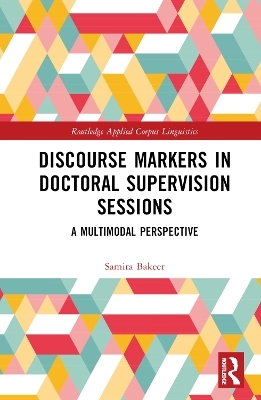
Discourse Markers in Doctoral Supervision Sessions
Routledge (Verlag)
978-1-032-02595-7 (ISBN)
Language is a complex system that transfers ideas, feelings, experiences, beliefs, and cultures to others. One of the interactional resources that are utilised to make this transmission more coherent and effective is Discourse Markers (DMs). This monograph analyses these markers in doctoral supervisions but uses a multimodal approach to provide a deeper understanding of these DMs and uncovers potential hidden meanings that would escape a purely verbal analysis.
Using a dataset consisting of a corpus of video-recorded doctoral supervision meetings, this book provides an innovative and cutting-edge approach to the analysis of DMs and sheds new light on the complexity and dynamicity of naturally occurring discourse where meaning-making rests on a close coordination of both verbal and embodied conducts.
The book makes very useful reading for scholars in the fields of discourse markers, conversation analysis, corpus linguistics and multimodality. It could collaterally be appealing to anyone simply interested in the study of human communication.
Samira Bakeer is a Senior Lecturer at the school of English at Misurata University, Libya.
List of Figures
List of Tables
Acknowledgements
Chapter 1: Introduction
1.1 Preliminary remarks
1.2 Why the context of doctoral supervision?
1.3 Extending the boundaries
1.4 Overview of the book
References
Chapter 2: Discourse marker as a field of inquiry: Connecting meaning, context, and multimodality
2.1 Terminology and definition
2.2 Commonly defined features
2.3 Major frameworks for analysing DMs
2.3.1 Coherence-based approach
2.3.2 Relevance-based perspective
2.3.3 Grammatical-Pragmatic Perspective
2.3.4 Corpus-based Approach
2.4 The functions of DMs adopted in the study
2.5 The influence of context
2.5.1 Supervisory sessions as an instance of academic discourse
2.5.2 Previous studies on DMs in supervision contexts
2.6 DMs from a multimodal perspective: Identifying the research gap
2.6.1 Multimodality: Definition and classifications
2.6.2 Gesture types
2.6.3 Speech-gesture interface
2.6.4 Speech-gesture synchrony
2.6.5 DMs from a multimodal perspective: Relevant Studies
2.6.6 Challenges in multimodal DMs research
2.7 Summary
References
Chapter 3: Methodological considerations
3.1 Corpus linguistics
3.2 Conversation Analysis
3.2.1 Knowledge and Epistemicity
3.2.2 The interactional practices of Affiliation and alignment
3.3 Case study
3.4 The data
3.4.1 Context and research participants
3.4.2 Data collection
3.4.3 Data processing
Selection of DMs
Identifying functions of DMs
Ethical considerations
References
Chapter 4: Towards a multimodal analytical framework
4.1 Transcriptions and annotation
4.2 The multimodal coding scheme
4.2.1 Hand gesture
4.2.2 Head gesture
4.2.3 Body Posture
4.2.4 Prosodic features
4.3 Reliability and validity
4.4 Summary
References
Chapter 5: Insights from corpus analysis
5.1 DMs at the textual level
5.1.1 Overall frequency and distribution
5.1.2 Functional profile
5.1.3 The positioning in turns
5.1.4 Combinations of DMs
5.2 DMs at the Prosodic level
5.2.1 Distribution of tone patterns
5.2.2 Position of DMs and tone choice
5.2.3 Prosodic properties of DMs and their pragmatic functions
1. The falling tone
2. The rising tone
3. The level tone
4. The fall-rise tone
5. The rise-fall Tone
5.3 DMs and the co-occurrences of embodied resources
5.3.1 Frequency analysis
5.3.2 Identifying gestures patterns and functions
5.3.2.1 Hand movements
1. The throwing-away gesture
2. The palm-side epistemic gesture
3. The ring gesture
4. Palm-up open hand gesture
5.3.2.2 Gaze and facial movements
5.4 Concluding remarks
References
Chapter 6: 6. Case study 1: Supervisory discourse in an English studies domain
6.1 DMs in Student 1’s speech
6.1.1 You know
6.1.2 I don’t know and gaze orientations
6.1.3 Or something like that: The brushing aside gesture
6.2 DMs in Supervisor 1’s speech
6.2.1 So
6.2.2 Well
6.3 Concluding remarks
References
Chapter 7: Case study 2: Supervisory discourse in an engineering studies domain
7.1 DMs in Student 2’s speech
7.1.1 I mean: Enhancing the clarity of the communicative act
7.1.2 I think: Assertiveness vs tentativeness
1. The role of chopping gestures in highlighting strong opinions
2. Expressing a negotiated opinion
7.1.3 The palm-up open hand gesture with so and honestly
1. The case of the PUOH gesture with so
2. The case of the PUOH gesture with honestly
7.2 DMs in Supervisor 2’s speech
7.2.1 But
1. Signalling mitigated disagreement
2. Marking a direct contrast
3. Indexing speaker’s return to main topic
4. The meaning of Open Hand Prone gesture with but
7.2.2 The role of duration in disambiguating the functions of well
7.3 Concluding remarks
References
Chapter 8: The interactional architecture: DMs in different types of speech-exchange systems
8.1 Organisational talk: Manifestations of persuasion vs. power
8.2 Instructional talk and advice-giving
8.2.1 Advice and the embodied display of precision
8.3 Argumentative talk and the management of (dis)alignment
8.4 Discursive talk and the negotiation of epistemic displays
8.4.1 Creating a sense of Collectivity
References
Chapter 9: Concluding remarks
9.1 Overarching conclusions
9.2 The influence of context
9.2.1 DMs and Rapport management
9.2.2 The negotiation of identity
9.3 What understandings can a multimodal perspective on DMs offer?
9.3.1 The body as a resource for the negotiation of epistemicity
9.3.2 Gesture as assistance of Self-disclosure
9.3.3 The embodiment of precision
9.3.4 DMs and the Interface of prosodic prominence and hand gesture
9.3.5 Revisiting the characteristics of DMs
9.4 DMs and the dynamics of doctoral supervision: Two possible factors
9.5 Implications and further perspectives
References
Index
| Erscheinungsdatum | 03.10.2023 |
|---|---|
| Reihe/Serie | Routledge Applied Corpus Linguistics |
| Zusatzinfo | 15 Tables, black and white; 5 Line drawings, black and white; 23 Halftones, black and white; 28 Illustrations, black and white |
| Verlagsort | London |
| Sprache | englisch |
| Maße | 156 x 234 mm |
| Gewicht | 453 g |
| Themenwelt | Schulbuch / Wörterbuch ► Wörterbuch / Fremdsprachen |
| Geisteswissenschaften ► Sprach- / Literaturwissenschaft ► Anglistik / Amerikanistik | |
| Geisteswissenschaften ► Sprach- / Literaturwissenschaft ► Literaturwissenschaft | |
| Geisteswissenschaften ► Sprach- / Literaturwissenschaft ► Sprachwissenschaft | |
| ISBN-10 | 1-032-02595-6 / 1032025956 |
| ISBN-13 | 978-1-032-02595-7 / 9781032025957 |
| Zustand | Neuware |
| Informationen gemäß Produktsicherheitsverordnung (GPSR) | |
| Haben Sie eine Frage zum Produkt? |
aus dem Bereich


